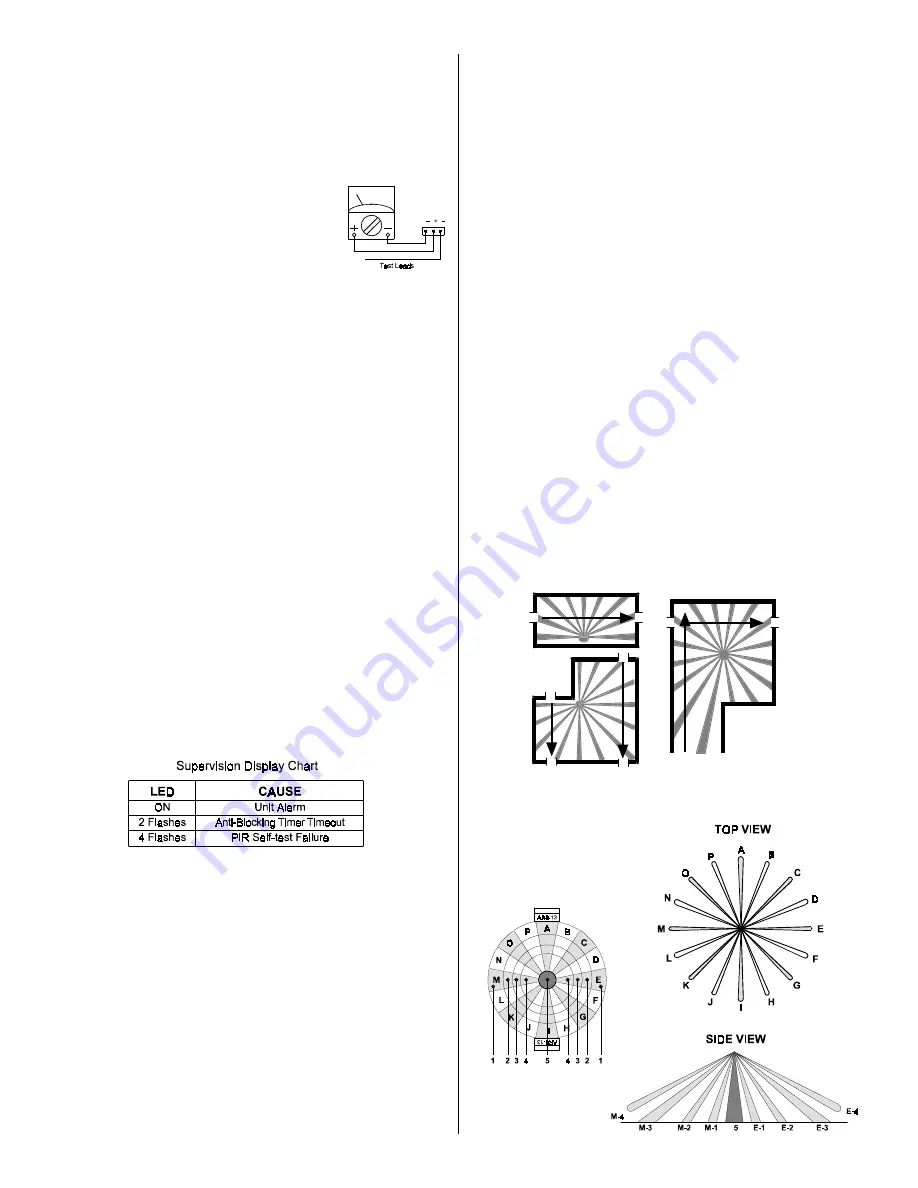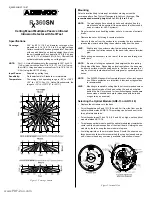
Page 3
Final Tests
Noise Measurement
NOTE:
Meter readings are very important in determining background
disturbance levels and catch margin sensitivity.
•
Connect a 20,000 ohm/volt (or greater) DC VOM to the Noise Voltage
connector using the test leads as shown. Set meter scale for about
3.0 VDC.
•
The base reference level for reading background
noise or target voltages is approximately 2.0 VDC.
Installations in quiet environments, therefore, will
result in a steady meter reading between 1.9 and
2.1 VDC. Look for areas and sources of thermal dis-
turbances if the meter fluctuates greatly.
False Alarm Prevention
•
Turn on all heating and cooling sources that would normally be in op-
eration during times of protection. Stand away from the unit and out-
side the coverage pattern, then monitor the background noise for at
least three minutes.
Readings should not deviate from the reference level more than ±0.15
VDC. For readings outside these limits; eliminate the cause, rotate the
unit slightly, or mask out the mirror segment(s) looking down at the
thermal disturbance.
Coverage Margin
•
Again walk across the farthest edge of required coverage.
A minimum voltage change of 1.0 VDC from the reference level is
required in the wintertime when the background temperature is cool.
This will make up for summertime, when the background is warmer. If
testing the unit in the summertime, the minimum recommended volt-
age change is 0.75 VDC.
•
When testing is completed, remove the test leads, and twist-lock the
cover into place.
Supervision Features
The R
X
360SN performs several supervision features that, combined with
the advanced motion detection capabilities of the detector, provide an
extremely high level of security. A supervision trouble condition is
indicated at the detector by the Alarm/Test LED (see the Supervision
Display Chart).
•
The LED indicates the cause of the supervision trouble using coded
pulses.
The supervision features function as follows:
•
PIR: The operation of the PIR is electronically checked approximately
every 12 hours, even without motion. The test may also be initiated by
the multiplex control. If the PIR fails, the Alarm/Test LED will flash four
times per second and a trouble signal will be sent to the multiplex
control.
•
Anti-Blocking Timer Supervision: This feature verifies that the de-
tector has a clear view of the detection area and has not been blocked.
A trouble condition will be indicated if the detector has not alarmed at
least once during the selected time period.
Refer to
Configuration Switch Settings for proper switch settings.
If the time period selected has elapsed from the last alarm and no
motion has been sensed by the detector, the LED will flash two times
per second and a trouble signal will be sent to the multiplex control.
The anti-blocking timer time period may be set for 3 to 30 days. This
feature may also be disabled by setting the anti-blocking timer configu-
ration switches S2 and S3 in the OFF position.
Other Information
Anti-vandal Tie-down
•
After the cover has been installed and twisted into place, the entire
assembly can be secured together using the supplied anti-vandal
screws. There are two of them; one for each side.
Optical Module Masking
•
Peel-off masks are provided with the unit for each segment of the opti-
cal module to allow for customized coverage, or to block out areas of
objects that may cause thermal disturbances. The mask is self-adhe-
sive and pre-cut in the shape of the optical module.
•
To block out a particular zone or group of zones, peel off a section of
the mask that corresponds to the appropriate zone, and stick it on the
mirror segment. See
Mirror Module to Pattern Reference to identify
mirror segments and zones.
Maintenance
•
At least once a year, the range and coverage should be checked ac-
cording to
Setup and Walk Testing and Final Tests above.
•
To ensure continued daily operation, the end user should be instructed
to daily walk through the far end of the coverage pattern. This assures
an alarm output prior to arming the system.
U. S. Patent Numbers
•
The R
X
360SN is protected by the following U. S. patents: #4,764,755,
#5,083,106, and #5,670,943.
Typical Placements to Achieve Coverage
Mirror Module to Pattern Reference
www.PDF-Zoo.com






















